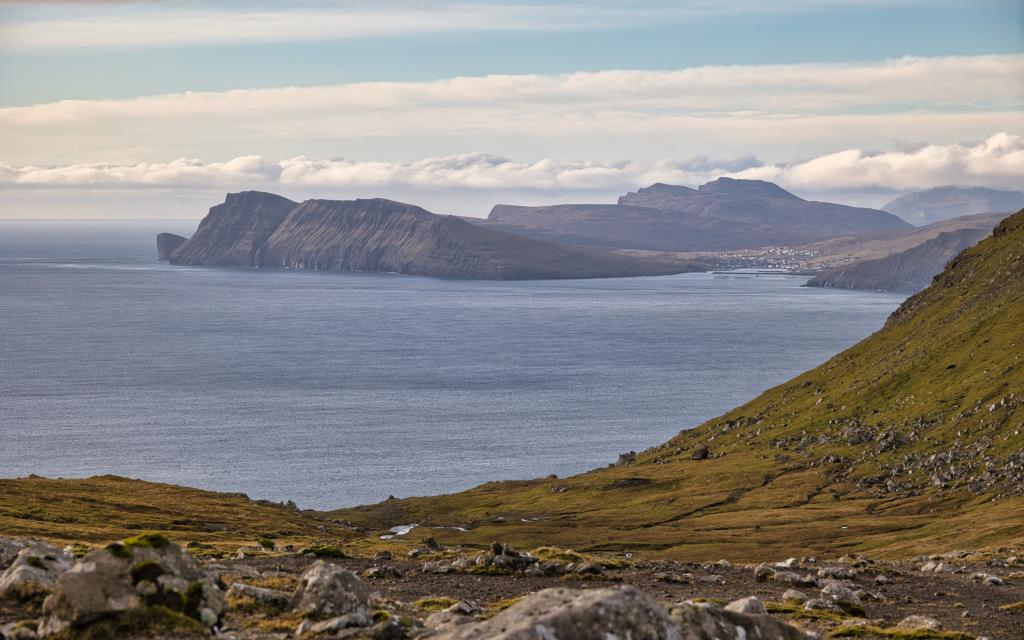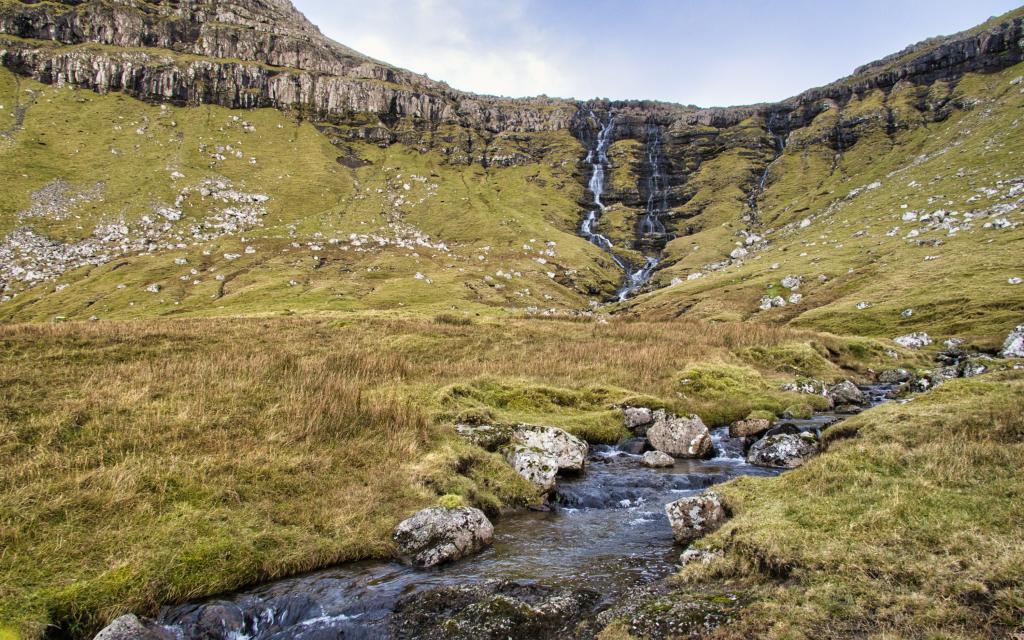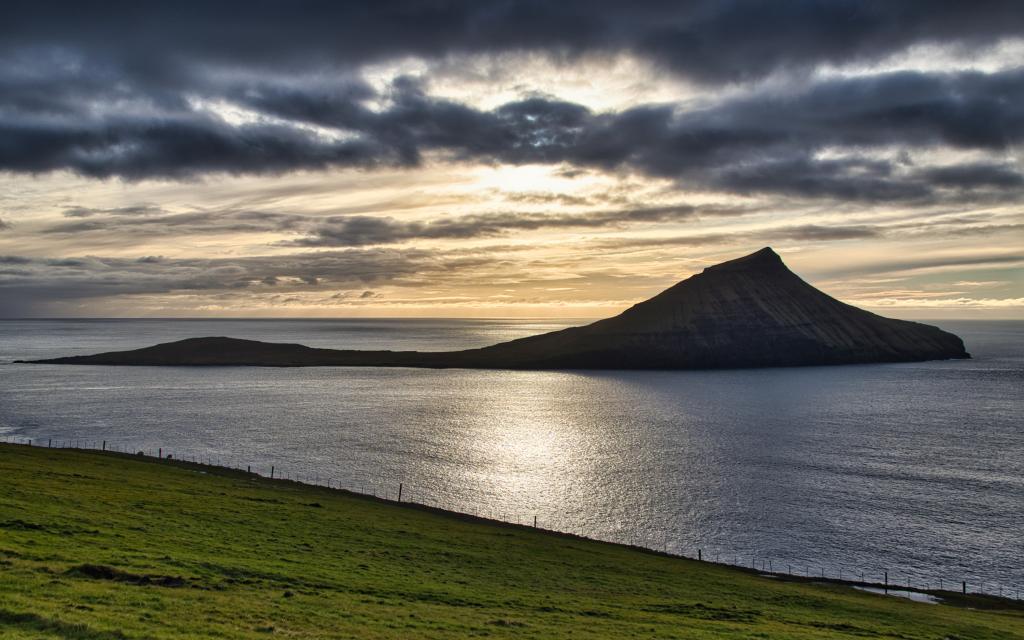Tórshavn - Syðradalur

A varied, pleasant and beautiful hike on a bridle path, passing the windmills at Flatnahagi, continuing across the dam in Havnardalur, then westward up the pass Dalsskarð before descending to the village of Syðradalur through the steep pass Sunnaraskarð, which is only passable on a dry summer day.
Since the crags of the pass Sunnaraskarð above the village of Syðradalur are very steep, it is recommended to only pass through them in summertime when it is dry. However, you can always take the hike west to Sunnaraskarð and enjoy the views before turning back to Tórshavn.
The hike starts on the road Oyggjarvegurin, by the parking lot about 200 m above Marknagil, just above a racecourse. To the west of the racecourse, you will spot the first cairn on top of a boulder.
In the past, when people from Tórshavn walked to Syðradalur, the main road they would take out of town was called Dalavegur (Valleys’ Road) as it was the road to the two villages Syðradalur and Norðradalur (South Valley and North Valley).
Those who travelled on foot used the lower road, out through the valley Havnardalur, continuing up and over the pass Dalsskarð.
Those who had packhorses took the high road as it was impossible to take the horses through Sunnaraskarð above Syðradalur. These would take the wide pass of Sundshálsur and continue up and over the pass Reiðskarð.
The journey into Havnardalur on the road Landavegurin was also in much use in more recent times. The road was built in 1936 in order to take the good peat from the out-of-the-way peatlands of Havnardalur. The road led up to the crags of Havnardalur by the river Gunnisá and continued up to Dalsskarð. The road was partly paid by a peat tax.
When Oyggjarvegurin was constructed in the 1950s, going north of the pass Sundshálsur, across Mt. lítla Runufjall to the river Grøv, people would drive north to the river and then walk across Reiðskarð to Syðradalur. Since then, the village path over Dalsskarð has been used less and less, and has therefore not been maintained, and many of its cairns have fallen down.
Follow the cairns leading you in a westward direction. The path is good, and the walk is pleasant with good views to the west, where you will, as you ascend, see the island Hestur appear beyond the pass Velbastaðhálsur. Here you often meet people on foot or horseback. If you meet horses on the path, it is polite to go 2-3 m off the path and stand still until the horses have passed you—so not to surprise them.
When you reach the river Tvørá, leave the path and follow the cairns up through the windmill park. It is easy to walk over the fairly even and grass-covered terrain across the field Flatnahagi. At one point, you cross the road leading to the windmills. As you descend toward the dam in Havnardalur, and when you are in line with the dam, turn down toward it. When you reach the path by the reservoir, follow it across the dam, and remember to enjoy the views over the fields of Havnardalur. The water reservoir was built in 1966 when Tórshavn’s population had reached 10,000.
Having reached the other side of the dam, walk about 350 m northward on the western side of the reservoir. It is a beautiful walk, especially when there is no wind, and you see everything reflect in the water. On the ridge between the two big rivers on the western side, you will see a cairn that has fallen down. From here, you walk straight up Dalsskarð over the grassy hill. The next cairn is about 200 m further up. From here, the cairns stand relatively close to each other all the way to Sunnaraskarð above Syðradalur. The final stretch up to Dalsskarð is somewhat rocky but still good for walking.
When ascending from the reservoir, the views down through Havnardalur get better. This is where the townsfolk had their good but not very accessible peatlands. Though no one cuts peat anymore, townspeople still head into the valley to relax and walk in the beautiful surroundings. Many people have rights to fields here, scouts have their club houses and riding clubs their barns, tracks and halls.
Nearing the apex, you will have a good view over the island of Nólsoy and north toward the island of Eysturoy, where you see its mountains, the spit Raktangi and parts of the fiord Skálafjørður with the Northern Isles in the background.
When you have reached the top of Dalsskarð, your views westward only become better and better. Down through the valley called Millum Skørðini, an amazing view with Vágoy island in the background awaits you. Go to the edge of the pass, sit down and enjoy the views with a cup of coffee before returning to Tórshavn. Or, if you are brave, continue down through the steep crags—but this is not a venture for those who suffer from vertigo. And, as mentioned, it is not advisable to go down through the crags except on a dry summer day wearing good hiking booths. Be careful and make sure to wear clothes that do not easily slip on gras.
There are many who take this hike. In the past, the postman took the path twice a week with mail to Syðradalur.
When you go down from the cairn above Sunnaraskarð, descend down the northside of the waterfall, never being more than 20 m from the fall, in this way:
• Descend 6 m down from the cairn, then veer left toward the river, and continue down below the first crag.
• Continue 10 m down through the grass-covered patch to the lower part of the crags.
• Take a left toward the river and then veer right down through the high crags, down to the grassy filed. This is the most difficult section. Where the rock is wet, it can be very slippery. In places you will need to squat down or crawl. In places, you will find a rocky path.
• When you have come down to the grass-covered area, veer again to the left toward the river, and then switchback down the grass-covered ridge until you reach the field below to crags.
Use the GPX file to guide you.
Tórshavn - Syðradalur
There is good parking at the parking lot 200 m above Marknagil—note the green line. This is just above the start of the racecourse at Marknagil. From here, follow the blue line westward down from the parking lot, where you will spot the first cairn at a distance of about 75 m.
Note also that about 200 m below the road, you will also find good parking at Marknagil. You can always park down in the large parking lot by the cattle grid above Hotel Føroyar, where you can either take Oyggjarvegurin or the racecourse and from it continue on the bridle path up to the village path.
Syðradalur - Tórshavn
You will find good parking in Syðradalur at the first turn in the road above Syðradalur by the river Syðradalsá—see the green line. From here, follow the blue line across the river and then up through the crags left of the river (north of the river).
Tórshavn - Syðradalur
Syðradalur - Tórshavn
Facts
Duration
distance
Peak
Elevation









